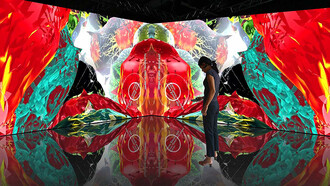Faiyum paintings, mummy portraits, or Wojooh Al-Faiyum, "Arabic for faces of Faiyum," remain among the most magnificent art pieces found from the era of Roman Egypt, which was the golden age of painted panel portraiture between the first and third centuries BC. These portraits were discovered in the Egyptian governorate of Faiyum. They were painted for men, women, and children from the rich upper class and local elites with realistic features, using the Greco-Roman style for painting. However, the purpose of painting the faces of Faiyum was mainly derived from Egyptian religious beliefs about death and the afterlife.
After Cleopatra’s defeat at the Battle of Actium in 30 BC against the Romans, Egypt became a province of Rome. Roman settlers absorbed native Egyptian customs and traditions, among which was mummification. Later, a new trend of burials started due to the diversity of Egyptian society at that time. The most noticeable aspect of this trend was painting people's faces on wooden panels and placing them over the heads of their mummies.
Some archeologists and historians believed that mummy paintings were completed after the portrayed people passed away; using CT scans to determine their age proved this point of view, as archeologists found that those people died approximately the same age as they appear in the portraits. Others thought that they were probably painted during their lives because some of the paintings had signs of being framed previously.
The majority of the portraits were painted on wooden boards or panels. They were usually made of lime tree wood due to its high quality. The wood was being sliced into thin, rectangular sheets. They can be bent using steam, allowing the painted picture to be attached to the mummy.
There are two main painting methods used for creating the portraits: the first one was by mixing pigments with animal glue; this technique is known as tempera. The other method is called encaustic, which is known for using beeswax mixed with pigments. The second technique was used more often in painting most of the mummy portraits.
The news of Faiyum portraits and mummies started to spread in Europe during the seventeenth century, especially after Pietro Della Valle, who was an Italian musicologist, author, and traveler of the Renaissance period, transferred two complete mummies to Europe and described them in a book he wrote about his travels. This book attracted European art dealers and archeologists to excavate this area.
Early in the nineteenth century, British and French archeologists launched multiple excavations. They found a large number of paintings at ancient burial sites. In 1887, a lot of mummies with their portraits were discovered in the area near el-Rubayat village in Faiyum. Then, these works were exhibited in European and American cities before being sold around the world.
Another site called Hawara, which is also located in Faiyum, became extremely important in the Roman era and appears to have served as the elites’ cemetery for the people of Faiyum, where many buried mummies with their panels were discovered by English archaeologist W. M. Flinders Petrie. The vast majority of mummy portraits that were transferred to the United Kingdom were found on this site.
Nearly 900 paintings were found between the 19th and 20th centuries by art dealers and European looters who sold them around the globe.
Unfortunately, some of the panels were detached from their mummies, and they are being displayed separately from the actual context in which they were found. Consequently, archeologists are not able to confirm the identities of these portraits. Other panels remained attached to the mummies, such as the ones exhibited in the British Museum and Manchester Museum.















